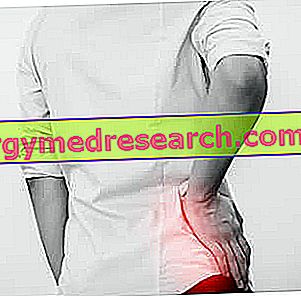Generality
Periarthritis is the chronic inflammation of one or more structures that make up a joint.

According to scientific studies, several factors would contribute to the development of periarthritis, including: age over 50, female sex, past joint injuries and diabetes.
The typical symptoms and signs of a periarthritis are: joint pain, joint stiffness and joint swelling.
Among the most common types of periarthritis in humans are: periarthritis of the shoulder, also known as frozen shoulder, and periarthritis of the hip.
Short anatomical reference on the joints
The joints are anatomical structures, sometimes complex, which put two or more bones in mutual contact. In the human body, there are about 360 of them and their task is to keep the various bone segments together, so that the skeleton can fulfill its function of support, mobility and protection.
The anatomists divide the joints into three main categories:
- Fibrous joints (or synarthrosis ), lacking in mobility and whose bones are joined by fibrous tissue. Typical examples of synarthrosis are the bones of the skull.
- Cartilaginous joints (or amphiarthrosis ), with poor mobility and whose bones are linked by cartilage. Classic examples of amphiartrosis are vertebral vertebrae.
- The synovial joints (or diarthrosis ), provided with great mobility and made up of various elements, including: the so-called articular surfaces, the joint capsule, the layers of cartilage that cover the articular surfaces, the synovial membrane, the synovial bags and a series of ligaments and tendons.
Typical examples of diarthrosis are the joints of the shoulder, knee, hip, ankle, etc.
What is periarthritis?
Periarthritis is the medical term that indicates any inflammation of a tendentially chronic nature, against one or more elements constituting a synovial joint.
Specifically, the elements of a synovial joint, which can catch fire in the presence of a periarthritis, are: the joint capsule, the tendons, the ligaments and the layers of cartilage that cover the articular surfaces.
Tendons, ligaments and articular cartilage: what are they?
A tendon is a formation of fibrous connective tissue, which joins a muscle to a bone element.
A ligament is a formation of fibrous connective tissue, which connects two bones or two distinct parts of the same bone.
Finally, articular cartilage is a connective tissue, which resides in the joints most subjected to mechanical stress.
ORIGIN OF THE NAME
The term periarthritis includes the prefix of Greek origin " perí " (περί) - whose meaning is "around" - and the word "arthritis" - which indicates the presence of an inflammation of one or more joints.
So, literally, periarthritis means "inflammation of what is around a joint".
Causes
Currently, the precise causes of periarthritis are unclear.
According to various scientific studies, several factors contribute to the development of this particular form of joint inflammation, including:
- Age over 50;
- The female sex;
- A past history of injuries or surgeries against the joint suffering from periarthritis. Accidents include not only dislocations, sprains and dislocations, but also episodes of tendinitis, synovitis, inflammation of the articular cartilage, etc .;
- Diabetes. For reasons that are still unknown, diabetics are twice as likely to develop periarthritis than people without diabetes;
- Efforts and / or movements performed repetitively with a certain articulation or part of the body. It is a situation that particularly affects people who regularly practice sports, such as running, walking, tennis, etc .;
- The different forms of arthritis, including: rheumatoid arthritis, osteoarthritis, etc .;
- Bad posture;
- The wrong execution and for long periods of a movement or a gesture, with a certain part of the body.
Symptoms
Joints prone to periarthritis are home to a variety of symptoms and signs, including: pain, stiffness, swelling, redness, a sense of warmth and reduced ability to move.
At an advanced stage, the aforementioned symptomatology can strongly affect the patient's quality of life. The latter, in fact, may encounter difficulties in performing, with the suffering joint, even the simplest movements.
WHEN TO REFER TO THE DOCTOR?
An individual should contact his or her attending physician (or an orthopedic specialist in joint pathologies) when he or she feels pain and stiffness in the joints, such that he cannot perform the simplest movements with the aching joint.
Diagnosis
In general, the diagnostic procedure that leads to the detection of a periarthritis starts with the physical examination and the anamnesis. Therefore, depending on the circumstances, it can proceed with: an x-ray (or X-ray), an ultrasound scan of the soft tissues surrounding the painful joint, a nuclear magnetic resonance, blood analysis, etc.
ADVANTAGES OF EARLY DIAGNOSIS
An early diagnosis of periarthritis makes it possible to treat the resulting inflammation with greater probability of success.
A late diagnosis, on the other hand, makes the treatment more difficult, which, consequently, does not provide the desired results.
Treatment
The treatment of periarthritis depends on the severity of the inflammatory condition and the severity of the symptoms.
The less severe forms of periarthritis also heal by leaving the ailing joint to rest for a certain period of time.
Forms of intermediate gravity also generally require conservative treatment, including painkillers, corticosteroids, stretching exercises and strengthening of muscles close to the painful joint and physiotherapy.
Finally, the forms of high gravity and not responding to conservative therapies require the intervention of the surgeon .
Types
Among the most known and widespread forms of periarthritis in humans, periarthritis of the shoulder and periarthritis of the hip deserve special mention.
SHOULDER PERIARRITIS
Also known as the frozen shoulder or adhesive capsulitis, periarthritis of the shoulder is a painful condition that affects the shoulder joint. The shoulder is the even region of the human body that marks the meeting between three bones surely known to most people: the clavicle, the scapula and the humerus.
Returning to the periarthritis of the shoulder, this pathology is mainly characterized by inflammation and the consequent swelling of the joint capsule.
According to several clinical studies, there are several risk factors that favor their appearance, including: a previous injury or previous shoulder surgery, diabetes, Dupuytren's disease, heart disease, stroke, hyperthyroidism, hypothyroidism, breast cancer, mastectomy and lung disease.
The symptoms and signs of periarthritis of the shoulder appear gradually, over several months (even nine!). The most characteristic clinical manifestations consist of joint pain and joint stiffness. In the most serious cases, the periarthritis of the shoulder prevents the performance of the simplest activities that require the use of the upper limb to which the suffering shoulder belongs.
Treatment depends on the severity of the symptoms and on how much it affects the quality of life of the patient.
In milder cases, rest is the best medicine and, in many cases, allows recovery to be achieved. However, it should be pointed out that remission times could be very long: in general, we talk about several months.
In cases of moderate severity, the therapy is conservative and includes: rest, painkillers, powerful anti-inflammatories (eg corticosteroids), strengthening of shoulder muscles and physiotherapy exercises.
Finally, in cases of high severity, therapy tends to be surgical. Surgery usually represents an extreme solution, which doctors only resort to after having tried any other type of conservative remedy.
PERIARRITITE OF THE HIP
Periarthritis of the hip is a particularly painful inflammatory condition, which affects the important joint that connects the so-called trunk of the human body to the lower limbs.
In this case, the hip joint places the connection of the acetabulum of the pelvis (in the trunk) with the head of the femur, which represents the bony element of the thigh.
Clearly, the hip is an even structure; in other words, there is a right hip and a left hip.
The hip joint is a fundamental joint element: without the hip, the human being would be unable to walk, run, jump etc.
Therefore, reconsidering the periarthritis of the hip, this pathology arises above all from the effect of an inflammatory state that regards the articular capsule, the cartilaginous tissues and the synovial bags.
Several clinical studies have shown that the risk factors of hip periarthritis are: the presence of particular forms of arthritis (including osteoarthritis and rheumatoid arthritis), a past history of traumatic hip injuries (eg, fractures ), the repetitive execution and for long periods of time of a certain movement with the hips, a wrong posture and the regular carrying out of sporting activities like the march or the road race.
The characteristic symptoms and signs of hip periarthritis consist of: pain in the upper part of the thigh (obviously the thigh connected to the suffering hip), joint stiffness, difficulty in movement (eg: escape lameness) and accentuation of pain in performing certain movements with the leg.
In general, the treatment of periarthritis of the hip is very similar to that of periarthritis of the shoulder:
- For the less serious cases of periarthritis of the hip, the resting of the painful joint is sufficient;
- For cases of periarthritis of the hip of intermediate severity, the therapy is conservative and includes, in addition to rest: painkillers, anti-inflammatories, muscle strengthening exercises for the painful lower limb and physiotherapy;
- For cases of high-severity hip periarthritis, therapy tends to be surgical .



